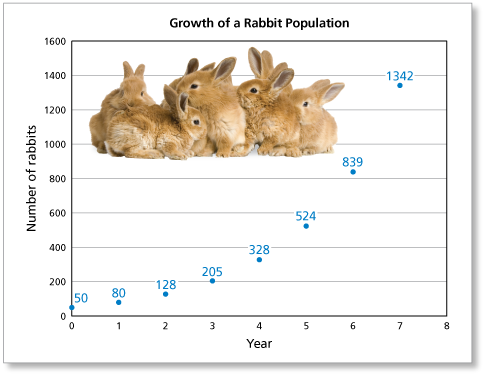Our ecosystem is made up of _______ and ________ factors.
biotic & abiotic or living & nonliving
Double Jeopardy!
Tulip poplars spread many seeds through "helicopter" pods which disperse away from the tree. Which of the following best describes the survivorship curve of the Tulip Poplar?

Type III
Which growth graph represents a population that reaches its carrying capacity.
Logistic growth pattern
Density _________ limiting factors includes disease, competition, and predation
dependent
An ecosystem that is devastated by a fire may eventually become populated with biotic communities as a result of
A. a decrease in the amount of organic material present
B. decreased levels of carbon dioxide in the area
C. the lack of abiotic factors in the area
D. the process of ecological succession
D. the process of ecological succession
Double Jeopardy!
The number of different species found in an ecosystem.
What is species richness
Double Jeopardy!
Moss does not have traditional roots, and instead absorbs water from the atmosphere. This makes moss susceptible to which of the following density-dependent limiting factors:
a. Overgrazing from animals like deer
b. Pollution
c. Drought conditions
d. competition from fungi
a. Overgrazing from animals like deer
d. competition from fungi
Which growth graph pattern is represented below?

Exponential growth graph
Double Jeopardy!
Fun fact! Some species of deer eat moss to keep their blood from freezing. What density-dependent limiting factors would most likely affect the carrying capacity of a deer population.
a. Competition over food sources
b. Pollution
c. Limited source of moss during a harsh winter
d. Predation from cayotes
e. Overhunting by humans for venison (meat)
a. Competition over food sources
c. Limited source of moss during a harsh winter
d. Predation from cayotes
A greater stability of an ecosystem would most likely result from
A. decreased finite resources
B. increased deforestation
C. increased biodiversity
D. decreased consumer populations
C. increased biodiversity
All groups answer!
How close neighboring species exist in relation to each other within an area? (Hint: one of two terms)
What is species evenness?
Double Jeopardy!
When deer graze on ferns, it spreads the fern's seeds in its feces or on it's fur. Several wolf packs have carved out territories in Yellowstone, and are preying on the deer. What is the dispersal pattern of the ferns, the deer, and the wolves respectively.
Ferns - Random
Deer - Clumped
Wolves - Uniform
The total number of individuals that an ecosystem can support.
carrying capacity
Triple Jeopardy!
In a forest community, a shelf fungus and a slug live on the side of a decaying tree trunk. The fungus digests and absorbs materials from the tree, while the slug eats algae growing on the outside of the trunk. These organisms do not compete with one another because they occupy
A. the same habitat, but different niches
B. the same niche, but different habitats
C. the same niche and the same habitat
D. different habitats and different niches
A. the same habitat, but different niches
Fish species A is able to live in either saltwater or freshwater, and can live in a wide variety of temperatures. Fish species B is able to survive in only saltwater and the water temperature has to be between 60 and 70 degrees. Which fish species would best adapt to changes in its niche environment?
Fish A
Double Jeopardy!
Which of the following represents an ecosystem with low species evenness, and low species richness?
a. An island with many rare birds and insects
b. farm growing thousands of sunflowers
c. An open field of grasses and wildflowers
b. A farm growing thousands of sunflowers
Triple Jeopardy!
An female octopus may lay between 20,000 to 80,000 eggs. She cares for the eggs until she starves to death. They eventually hatch on their own, but only one or two survive to adulthood. Which of the following best describes their growth pattern and survivorship curve?
a. Exponential growth
b. Logistic growth
c. Type I survivorship
d. Type II survivorship
e. Type III survivorship
a. Exponential growth
e. Type III survivorship
Double Jeopardy!
The Pisgah forest supports a mob of deer. Which of the following best describes the deer population's growth pattern and survivorship curve?
a. Exponential growth
b. Logistic growth
c. Type I survivorship
d. Type II survivorship
e. Type III survivorship
b. Logistic growth
c. Type I survivorship
The diagram below shows the ecological succession of a bare (empty) field. What type of succession is represented.

Primary Succession
Double Jeopardy!
Which of the following represents density independent limiting factors that could affect the stability of an ecosystem
A. hurricanes, packs of wolves, and temperature
B. blizzards, heat waves, and swarms of grasshoppers
C. droughts, floods, and heat waves
D. species of fish, number of decomposers, and supply of algae
C. droughts, floods, and heat waves
Double Jeopardy!
The high species richness (biodiversity) of an area can improve the ecosystems _______________
a. resilience
b. resistance
a. resilience
A species on which other species in an ecosystem largely depend, such that if it were removed the ecosystem would change drastically.
Keystone species
Double Jeopardy!
A mob of deer has 5 males and 21 females. During one year, 20 new fawns are born, and 7 adults were killed by hunters. That same year, 5 adults and 3 fawns were killed by predators. 3 males emigrated from the area. There were no immigrations. What is the population growth rate for the year, and how many deer remain alive.
2 individuals, 28 deer remain
Double Jeopardy!
A particular species of microscopic organism inhabits the intestines of termites, where it is protected. Wood that is ingested by the termites is digested by the microscopic organisms, forming food for the termites. The relationship between these two species can be described as
a. Commensalism
b. Mutualism
c. Parasitism
d. Toxic
b. Mutualism
This occurs when living organisms, including animals, plants, bacteria and fungi, need the same limited resources to thrive in their shared environment.
competition